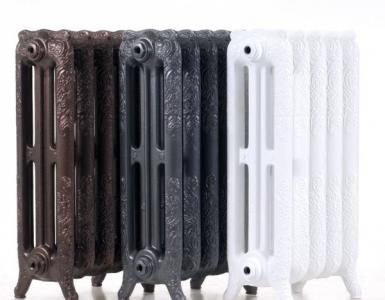Normative documents for heating residential premises. The basic standard of heat energy consumption for heating
Heating system
The cost of utilities is constantly growing, and every month they have to pay for them. If everyone is more or less clear about the calculation of payment for water consumption and use of sewerage, the required payment for heating to the majority of consumers seems questionable. Many residents are concerned about the question of why the amounts for the summer period differ from winter payments, and in the nearby house tenants receive receipts with completely different figures. Surely, this is worth considering.
What does the payment for the supplied heat depend on?
The standard of heat energy consumption determines that a comfortable temperature regime should be maintained and maintained in residential premises. It is established by certain rules for the supply of utilities.
Calculation of the standard is made in Gcal per 1 sq. Km. a meter of the total area of a private structure or apartment building. The following indicators are taken into account:
- The total heat energy consumption needed to heat the entire house during the period heating season. It is determined with the help of general house or individual heat meters.
- The total area of the heated house, taking into account the buildings connected to the heating system.
- Duration of the heating season, including incomplete calendar months, during which the measurements of the first indicator were made.
The calculation also takes into account the average daily temperatures of indoor and outdoor air at those times of the year when the houses have heating. In the first case, the values specified in the norms for the provision of public services are taken as a basis. In the second - averaged data for the 5 preceding heating seasons, provided by the regional hydrometeorological service.
There is another important parameter of the outside air - its average minimum temperature. Its calculation is based on measurements of the five coldest days of the winter season, located in a row.
AT middle lane Russia centralized heating of residential buildings is carried out within 7-8months. This occurs, usually from October to April or May. But in the first and last months the heat is supplied in part - before or after a certain number, as well as under the underestimated consumption rate. From November to March-April, it remains stable.
The order of charging can be different:
- The tariff for heat energy is averaged, and payment throughout the year does not change, despite the fact that there is no heating in the summer. In this case, the material load on the consumer is distributed evenly.
- In the coldest period of the heating season, it is necessary to pay a maximum, in the first and last months a little less, and in the warm season the payment is minimal or completely absent.
How payments are approved
Norms and tariffs are calculated and compiled by heat supply organizations with the involvement of specialists. Then they are approved by the energy commissions within a certain region, region or a separate settlement. Calculation of the proposed payment is submitted to the territorial commission. At its meeting, deputies of different levels and representatives of local executive authorities, including public organizations, are invited.
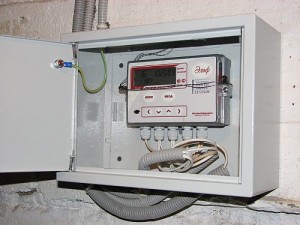
Meters for monitoring
Calculation of tariffs is carried out in accordance with a governmental decree establishing and determining what are the consumption standards for public services, in particular, for heating. Each heat pumping organization must be documented and justified, otherwise it will not go into the final payment for heating.
The approved tariffs and payment for heating remain unchanged until the next possible regulation, as well as determining the cost of the supplied coolant, which depends on many components.
How is the payment made?
The calculation for the supplied heat for consumers is made taking into account not residential, but the total area of the apartment or house. The consumption rate in Gcal / sq. M. m is multiplied by the tariff approved in each locality in rubles / Gcal. As a result, the cost of heating costs, expressed in rubles / sq. M., Is determined. m, which once again is multiplied by the number of common square meters of the dwelling. This amount is seen by consumers in their receipts.
In many settlements adopted a single. But if a meter is installed in a multi-storey building, the calculation is carried out individually. It can significantly differ from the adopted figure. The indicators of the metering devices and the total occupied area of each apartment are important here. In this case, the payment for heating will also include part of the cost of heat energy for additional home needs, for example, heating stairwells, tambours and cellars.
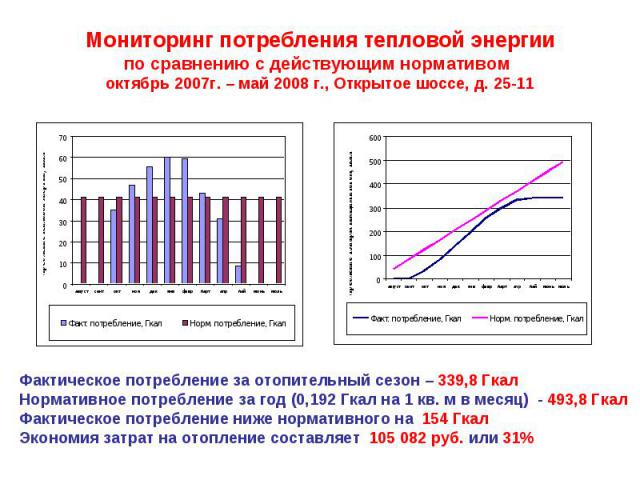
Monitoring of thermal energy consumption
The actual indicator of the outside air temperature during the heating season may be higher or lower than the daily average values, which were taken into account when the calculation of the heat consumption standard was made. Taking into account this fact, once a year, utilities recalculate. In the event of an overpayment, the owners of the house are counted against it as future accruals. And if the winter in the street was much frostier than determined by the standards, then consumers will have to pay an additional amount. Therefore, it is not necessary to panic if there is an incomprehensible figure in the receipt - in housing offices you can always find out where it came from. This applies to homes without heat-transfer temperature meters.
In multi-storey buildings with counters for the amount of heat consumed many factors influence. Some hosts install batteries with additional sections or simply increase the number of heating devices. Others warm the loggias and even on the balconies mount radiators. Someone is laying warm water floors throughout the apartment. All this increases the house heating costs for heating. In the end, it turns out that someone in the apartment is warmer, and someone has to pay for someone else's comfort out of their own pocket. After all, it is produced depending on the total area of the apartment, and not on the number of heating appliances.
So that the best option for accounting for the consumption of thermal energy and its material resources will be the installation of an individual meter, or meter.
Control of heat energy consumption
The meters installed in the apartment or private house allow you to monitor and closely monitor the amount of heat that has really gone to the heating of the premises. Therefore, consumers can significantly save on utility bills. Especially it is clearly visible in case if the radiators have a regulating armature.
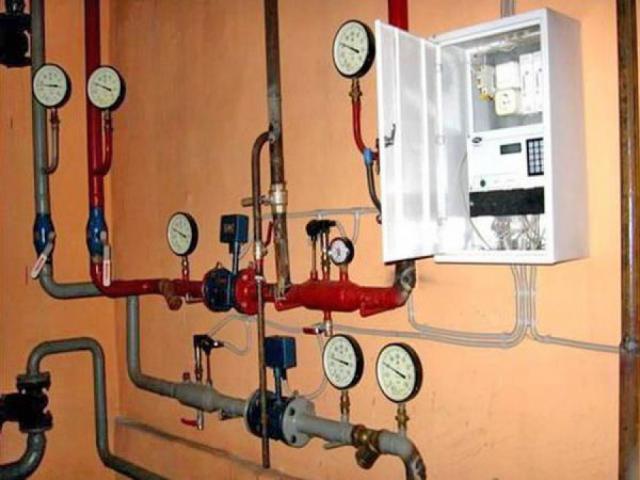
You can pay only for the received heat
It happens that in winter it is necessary to open windows or transoms due to the fact that centralized services do not correct the temperature of the coolant depending on the outside temperature of the air, and the batteries are heated more than required. Or vice versa - the tenants themselves feel not quite comfortable in cold apartments in a frigid frost.
Consumers without meters do not have a desire to save on utility payments for heat supply. Why further insulate windows or walls, if the house is already warm?
Another thing is the installation individual device accounting with the possibility of regulating the amount of incoming coolant. This measure pushes owners to prudence and thrift. It will be in their interest to carry out appropriate measures for the insulation of enclosing structures and openings. Yes, and do not have to pay for heating the neighbor. The calculation is very simple - how much it consumed, so much and paid.
To bet or not to bet?
The work of the heat meter consists in measuring and fixing the volume, pressure and temperature of the incoming coolant. Manufacturers produce two main models of household measuring instruments:
- tachometric - less accurate, but cheaper;
- ultrasonic - reliable, durable, differing in accuracy of measurements, but at the same high price.
Of course, an individual measuring instrument has a lot of advantages, and after a while it will pay for itself. But to think that everything will end with the allocation of material means only for its acquisition is not entirely correct. Independently heat meters are forbidden to be installed, therefore in cost calculation it is necessary to add the cost of installing a set of equipment, which can amount to 2 times the price of the meter itself.
The installation is handled by specialized companies that have permits for such work.
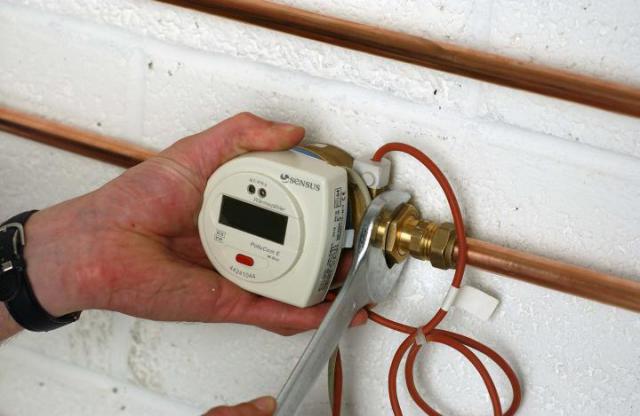
Installation of heat metering devices
In addition, do not forget that the measuring device should be inspected every 3-4 years, for which you will also have to pay a certain amount.
When choosing a heat meter, it is necessary to pay attention to the availability of a technical passport and certificate, and after its installation - on the mandatory presence of a seal. The delivery set includes not only a measuring instrument, but also stop valves, located before and after it.
The counter will help to really save the family budget, as the consumer will pay only on his accounts without taking into account the losses of the public utilities. As a result, the services will have to be put in order heating network, start to tightly control the shortcomings and deliver quality services.
Whom to entrust the installation?
It is inadmissible to involve amateurs for installing appliances to account for heat consumption. Specialists of the profile company must provide:
Authorization documents:
- certificates;
- tolerances;
- certificates, including on state registration.
- Extract from the Unified State Register of Legal Entities, containing information about the provider of services.
- Guarantees and service possibilities.
- Benefits of certain categories of citizens, established by law.
- Plan of installation, specifications and estimates.
- Opportunities and the period of granting installments.
Possible exit from the situation
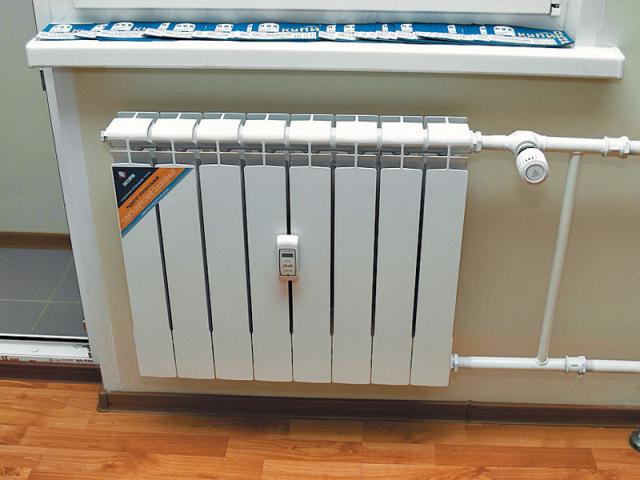
Radiator
With horizontal distribution of heating pipes in the house or apartment, there are no problems when installing heat meters. They have compact dimensions and can be easily placed on straight sections of pipelines, through which the coolant enters. If necessary, the measuring equipment can be installed on the return.
But not every apartment house it is possible to install an individual apartment heating meter. The houses of old buildings are equipped with vertical piping, so the risers are in each room. And to put several meters in one apartment does not make sense. This will result in a decent amount and is unlikely to meet expectations.
But do not be discouraged. Producers took care of such heating schemes and proposed another option for accounting for heat energy - distributors. They measure the difference in temperature on the surface of the heating appliances and air in the room, on the basis of which the flow rate of the coolant is determined. The cost of distributors is 6-8 times less than heat meters, and the costs for their installation are much more modest.
Another way out is to install a house-wide meter of energy consumption spent on heating. In this case, all owners of apartments must give their written consent. The following are compiled:
- a statement in the affiliated housing office;
- request to the district service of heating systems for the possibility of installing instruments.
After a certain time:
- heating systems issue TU;
- a contract is concluded with a specialized enterprise for the installation of equipment;
- installation of devices and components, as well as shut-off, distribution and control valves is performed.
What to do after installation?
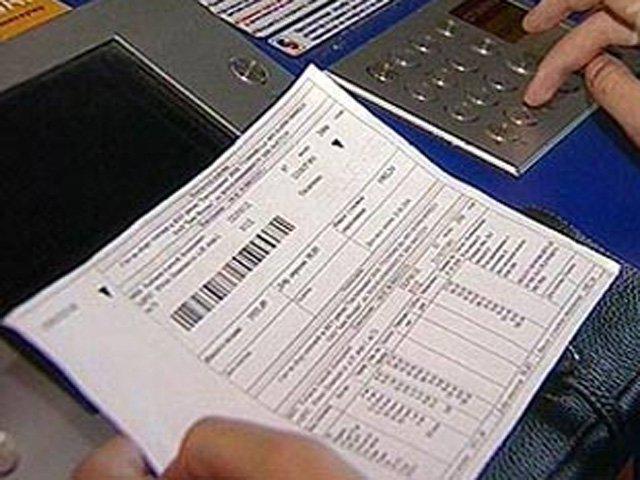
Calculation of expenses
Owners of any housing are obliged to treat carefully the devices for the calculation of thermal energy. They answer:
- for the safety of equipment;
- current checking and replacing the counter;
- correct taking of indications and their transfer to heat supply services;
- timely payment of consumed heat energy;
- representatives of heat networks to the meter to verify the testimony provided by the consumer.
Usually documentary registration after the installation of metering devices are handled by companies that have installed them. But some consumers do this on their own, although walking through the authorities takes a long time.
Norms provide for the commissioning of the meter not later than a month after its installation. And payment according to the indications starts on the next day after the commissioning.
Verification of the reliability of the readings of the meter is allowed to be performed if the consumer has not provided them for more than three months. At the same time, the heat supply organization must notify the owner about the possible time of arrival of its representative and the consequences of non-admission to the meter.
Conclusion
Often consumers complain about unfair norms and tariffs for heating. Today this is the largest in terms of total communal payment. Many are not satisfied with the fact that neighbors have much warmer in the apartment, and in the receipts for heating put the same figures just because the total area is the same. And who is happy to pay for hot batteries at a time when it's already warm in the street? The way out of this situation is the installation of a device responsible for accounting for thermal energy.
THE GOVERNMENT OF MOSCOW
DECISION
of 11 January 1994 No. 41
On the standards of consumption of thermal energy and gas used to calculate the payment for utilities *
Removed from control in connection with changes in objective conditions on the basis of
of March 12, 1996 No. 215
____________________________________________________________________
____________________________________________________________________
Document with changes made:
decree of the Moscow City Duma of March 16, 1994 No. 22 (Vedomosti of the Moscow Duma, No. 3, 1994);
decree of the Government of Moscow of June 21, 1994 N 500 (Bulletin of the Moscow City Administration, No. 16, August 1994);
decree of the Government of Moscow of July 28, 1998 No. 566 (Tverskaya, 13, N 27.08-02.09.98);
decree of the Government of Moscow of January 12, 1999 No. 16 (Tverskaya, 13, No. 7, 11-17.02.99); (Bulletin of the Moscow City Administration, No. 4, 1999)
decree of the Government of Moscow of April 20, 1999 No. 331 (Tverskaya, 13, N 23, 03-09.06.99); (Bulletin of the Moscow City Administration, No. 12, 1999)
decree of the Government of Moscow of December 23, 2003 N 1062-PP (Bulletin of the Mayor and the Government of Moscow, No. 4, January 14, 2004);
decree of the Government of Moscow of November 29, 2011 No. 571-PP (Bulletin of the Mayor and the Government of Moscow, No. 67, 06.12.2011);
(Official site of the Mayor and the Government of Moscow www.mos.ru, July 15, 2015);
(Official site of the Mayor and the Government of Moscow www.mos.ru, 03.10.2016) (on the order of entry into force, see. paragraph 4 of the resolution of the Government of Moscow of September 29, 2016 No. 629-PP);
decree of the Government of Moscow of December 13, 2016 N 848-PP (Official site of the Mayor and the Government of Moscow www.mos.ru, 13.12.2016) (the changes took effect on July 1, 2017).
____________________________________________________________________
____________________________________________________________________
Acts in a part that does not contradict decree of the Government of the Russian Federation of June 18, 1996 No. 707 , canceled decree of the Council of Ministers - Government of the Russian Federation of September 22, 1993 N 935.
____________________________________________________________________
____________________________________________________________________
This decision was recognized as invalid on the basis of decree of the Government of Moscow of June 13, 2006 N 381-PP.
Decree of the Government of Moscow of June 13, 2006 N 381-PP It has lost force in the part of repealing this resolution - decree of the Government of Moscow of July 25, 2006 No. 538-PP.
____________________________________________________________________
________________
* The name in the wording put into effect decree of the Government of Moscow of September 29, 2016 No. 629-PP . - Cm. previous version.
In accordance with Housing Code of the Russian Federation The government of Moscow
(Preamble in the wording put into effect decree of the Government of Moscow of September 29, 2016 No. 629-PP . - Cm. previous version)
decides:
1. The item has become invalid. - See the previous edition.
2. The paragraph became invalid from January 1, 2012. - - Cm. previous version.
3. The paragraph became invalid from January 1, 2012 - decree of the Government of Moscow of November 29, 2011 N 571-PP . - Cm. previous version.
4. The paragraph became invalid from 1 January 2012 - decree of the Government of Moscow of November 29, 2011 N 571-PP . - Cm. previous version.
5. Approve the standards for the consumption of public services for the population (Appendix 4).
(A paragraph in the wording put into effect decree of the Government of Moscow of September 29, 2016 No. 629-PP . - Cm. previous version)
The paragraph became invalid from January 1, 2012 - decree of the Government of Moscow of November 29, 2011 N 571-PP . - Cm. previous version.
6. The paragraph became invalid from January 1, 2012 - decree of the Government of Moscow of November 29, 2011 N 571-PP . - Cm. previous version.
7. The paragraph became invalid from January 1, 2012 - decree of the Government of Moscow of November 29, 2011 N 571-PP . - Cm. previous version.
8. The paragraph became invalid from January 1, 2012 - decree of the Government of Moscow of November 29, 2011 N 571-PP . - Cm. previous version.
9. The paragraph has become invalid -, since January 24, 2004 - decree of the Government of Moscow of December 23, 2003 N 1062-PP. - Cm. previous version.
10. The paragraph has become invalid - decree of the Government of Moscow of June 21, 1994 N 500 - Cm. previous version.
11. The item has become invalid - decree of the Government of Moscow of September 29, 2016 No. 629-PP . - Cm. previous version.
12. The item has become invalid - decree of the Government of Moscow of June 21, 1994 N 500 . - Cm. previous version.
13. The paragraph became invalid from January 1, 2012 - decree of the Government of Moscow of November 29, 2011 N 571-PP . - Cm. previous version.
14. The paragraph became invalid from January 1, 2012 - decree of the Government of Moscow of November 29, 2011 N 571-PP . - Cm. previous version.
15. The paragraph became invalid from January 1, 2012 - decree of the Government of Moscow of November 29, 2011 N 571-PP . - Cm. previous version.
16. The paragraph became invalid from January 1, 2012 - decree of the Government of Moscow of November 29, 2011 N 571-PP . - Cm. previous version.
17. The point has become invalid - decree of the Government of Moscow of June 21, 1994 N 500 . - Cm. previous version.
18. The paragraph became invalid from January 1, 2012 - decree of the Government of Moscow of November 29, 2011 N 571-PP . - Cm. previous version.
19. The paragraph became invalid from January 1, 2012 - decree of the Government of Moscow of November 29, 2011 N 571-PP . - Cm. previous version.
20. Consider invalid paragraph 2 and 3 of the Moscow Government Decree No. 3 of January 5, 1993 "On the development of the concept of changing rent and housing subsidies in Moscow".
21. The point has become invalid - decree of the Government of Moscow of September 29, 2016 No. 629-PP . - Cm. previous version.
22. The control over the implementation of this resolution is to be entrusted to Biryukov PP, Deputy Mayor of Moscow in the Government of Moscow on housing and communal services and landscaping.
(Clause in the wording put into effect decree of the Government of Moscow of September 29, 2016 No. 629-PP . - Cm. previous version)
Prime Minister of Moscow City Government
Yu.M. Luzhkov
annex 1. Terms for a phased transition to a new system of payment for housing and utilities
Appendix No. 1
to Resolution
Moscow City Government
of 11 January 1994 No. 41
____________________________________________________________________
Lost power -
decree of the Government of Moscow of September 29, 2016 No. 629-PP. -
Cm. previous version.
____________________________________________________________________
Appendix 2. Rates of payment for hiring residential premises in the houses of the municipal and state housing stock of Moscow (lost force)
Appendix No. 2
to Resolution
Moscow City Government
of 11 January 1994 No. 41
____________________________________________________________________
Have lost force on the basis of
decisions of the Government of Moscow
from June 21, 1994 N 500 . - Cm. previous edition.
____________________________________________________________________
Appendix 3. Rates of payment for housing under the contract for hiring for maintenance and repair of houses in the municipal and state housing stock and rates of payment for maintenance services for citizens who privatized occupied ... (lost force)
Appendix No. 3
to Resolution
Moscow City Government
of 11 January 1994 No. 41
BETS
payment of housing under a contract for hiring for maintenance and repair of houses in the municipal and state housing stock and rates of payment for maintenance services for citizens who privatized occupied apartments (rooms), as well as houses of housing and communal services, housing maintenance of municipal housing organizations in Moscow
____________________________________________________________________
Have lost force on the basis of
decisions of the Government of Moscow
from June 21, 1994 N 500 . - Cm. previous edition.
____________________________________________________________________
Appendix 4. Norms of consumption of public services for the population
Appendix No. 4
to Resolution
Moscow City Government
of 11 January 1994 No. 41
(as amended on December 13, 2016)
unit of measurement | The rate of consumption in a month of the calendar year Gas consumption norm: | ||||
3.1. If there is a gas | m3 / person | ||||
3.2. If there is a gas | m3 / person | ||||
3.3. If there is a gas (The paragraph was added on January 1, 2017 decree of the Government of Moscow of September 29, 2016 No. 629-PP) (Note is additionally included from July 26, 2015 decree of the Government of Moscow of July 14, 2015 No. 435-PP) Norms of water consumption for household and drinking needs of the population in the housing stock of Moscow (lost power)(Introduced from 1 March 1994) Appendix 5. Rates of payment for public services for the population (lost force)Appendix No. 5 ____________________________________________________________________ Annex 6. Regulation on the procedure for granting subsidies to citizens for payment of housing and communal services in Moscow (expired)Appendix No. 6 ____________________________________________________________________ Appendix No. 8 ____________________________________________________________________ Revision of the document with |
What are the norms for heating? Which parameters are normalized? What values can the standard of heat energy use for heating? Let's try to answer these questions.
Basic concepts
Before explaining the meaning of the concept we are studying, we will get acquainted with several related terms and definitions.
Gigacalorie
Traditionally, thermal energy is measured in kilowatt-hours. However, for settlements for heat in the communal economy, another value is used - gigacalorie, or 10 ^ 9 calories. It is this unit of measure introduced because it is comparable to the monthly consumption of thermal energy for apartment buildings; more familiar to the consumer kilowatt-hours would mean prohibitively large numbers in the payments.
Important! The physical meaning of the concept of gigacaloric is simple: it is the amount of heat necessary to heat 1000 tons of water per degree on a Celsius scale at atmospheric pressure.
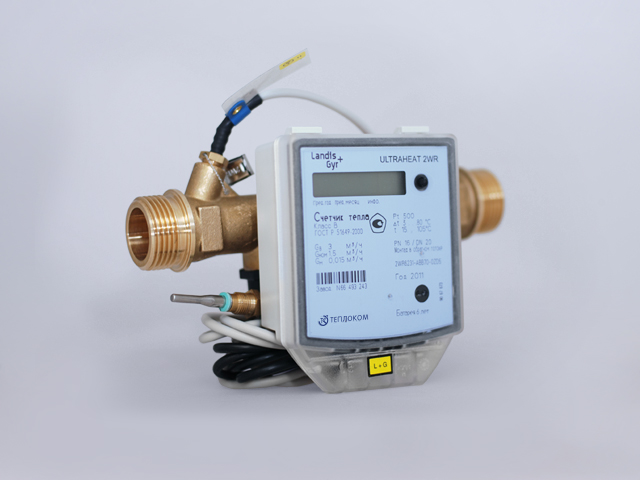
Temperature norms
The boundaries of the permissible temperature regime in residential premises can be found in sanitary rules and norms (SanPiN) under the number 2.1.2645-10. What are the current heating norms?
If the minimum rate of heating in an apartment is not met, its owner has the right to demand a proportional reduction in the payment for heating. The condition for the recalculation is the statement made on the basis of the temperature measurement by the representatives of the Housing and Communal Services.
Settlement scheme
The rate at which tenants pay for heat energy can be formed in several ways. In most regions of the country, tariffs are reviewed approximately every three years.

However: under certain conditions, the heating rates in the apartment, including the tariffs for heat, can vary more flexibly. Typical examples are the transfer of a house from one organization to another's balance sheet or the transition to other norms of state regulation that can be observed in the Crimea in 2014-2015.
What can be the schemes of formation of accounts?
Let's give some examples.
- In the presence of an apartment heat meter, the apartment owner pays for the actual consumption of heat by his apartment. The calculations use a fixed price of gigacalorie (in different regions it is 1500 - 2000 rubles).
- If a common heat meter is installed in the house, the total heat consumption is deduced from the change in its readings, which is distributed among the apartments in proportion to their area.
- Finally, if heat meters in the house and apartments are not available in principle, instead of the actual energy consumption, the calculation uses the norms for the consumption of heat energy for heating, derived from several factors:
- Of the Region. It is clear that in Yakutsk the heat consumption will be more than in Anapa.
- The quality of the facade insulation of the building.
- Number of Floors. The more of them, the less heat loss per unit area.
- Type of glazing.
- The terrain and the prevailing wind direction. They greatly affect the loss of heat through ventilation.
However: much more often the standards of heat energy consumption for heating operate on the territory of the whole region, regardless of the type of structure.
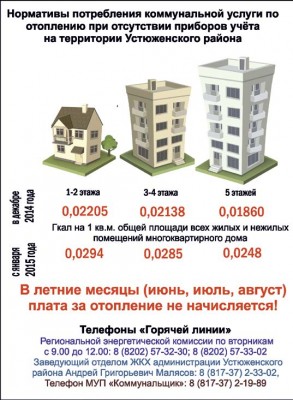
Intermediate option - linking to the region and the number of storeys of the house.
Definition
So, the norms of consumption of thermal energy for heating houses - this is the estimated amount thermal energy, which is necessary to maintain the normalized temperatures in them. They are measured in gigacalories at square meter for a month. Their values are set by local authorities.
Examples
Let us give concrete values that are currently in effect for some cities in the Far East.
Commentary: the example of Chegdomyn clearly shows the effect of introducing new requirements for thermal protection of buildings. According to the given norms, the values of heat losses in new and old houses differ threefold.

Recalculation
Even in houses without heat meters, where a fixed standard for heating, with aged temperature mode in apartments the recalculation can be carried out. It is carried out in those cases when the winter temperatures differed significantly from the calculated ones. In an unusually mild winter, you will receive a part of the payment made earlier, in especially severe - alas, an additional bill.

Common house needs
A number of common premises of a residential building need heating as well as apartments. This includes staircases and vestibules, wheelchairs and garbage chambers. For these rooms, the heating standard is much less than for residential; However, this is someone who needs to pay for the heat.
On whom the maintenance of common premises is entrusted - it is not difficult to guess: its cost is included in the bills for heating the apartments.
In the most common case - when only a house heat meter is installed, individual heat meters are not available - your share in the heating bill of the whole house (including common areas) is calculated as the product of the value of all the heat consumed by the house and the ratio of the area of your apartment to the total living area of the house.
For example, the area of the apartment is 50 m2, the total cost of consumed heat on the house meter is 50,000 rubles, and the total living area of the house is 1000 m2. Your payment this month is 50,000 * (50/1000) = 2,500 rubles.
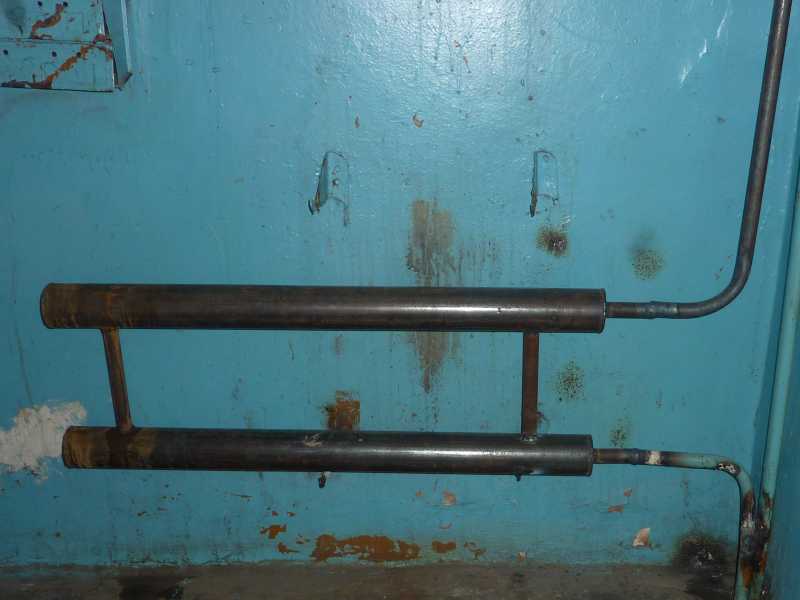
Saving on heating
Is it possible to reduce monthly payments for heat without giving up?
The only way to do this is to install an internal heat meter.
In new houses with horizontal wiring instructions for its installation with their own hands is extremely simple: the meter itself is placed in the gap of the supply thread of intra-apartment bottling, the return is supplied with a temperature sensor.
But in houses of old construction, where each radiator connects to its own riser, a number of problems will arise.
- The total cost of installing meters for 3-4 radiators will be at least 45 - 60 thousand rubles, which means a very long payback period.
- The counters on the piping take into account the heat consumption through the radiator; but the riser also contributes to the heating.
- A natural solution - to organize horizontal wiring from one riser with a single meter is also unacceptable in the vast majority of cases. A sharp increase in heat extraction from one riser will make your neighbors freeze.
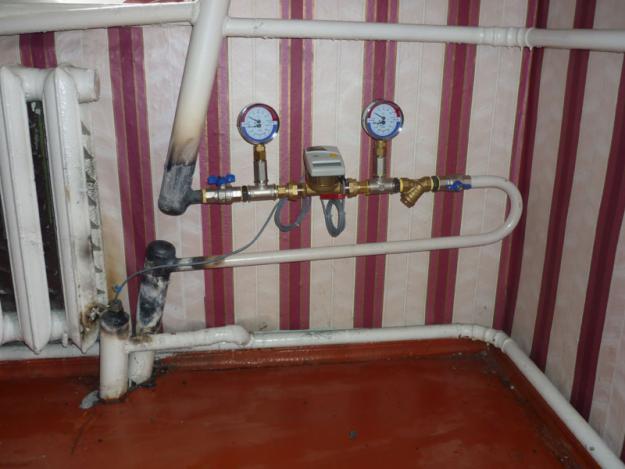
Conclusions are disappointing: while the standards for heating the apartment and the tariffs attached to them remain unchanged, it is not necessary to wait for the reduction of the accounts for heat.
Conclusion
We hope that our material has helped the reader understand the scheme of tariff formation. Current heating standards for residential areas for your region can be found on the resource of the local administration or the heat-selling organization ().




